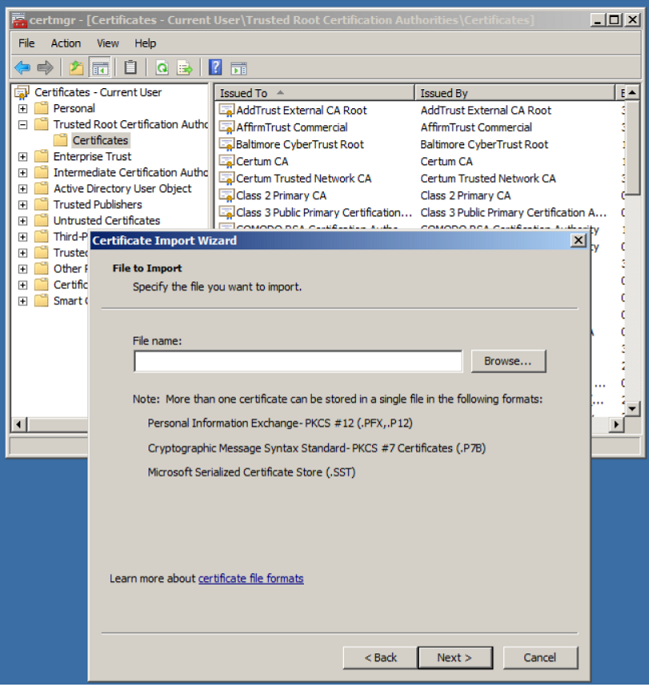

The command below will listen for connections on port 443 and requires 2 valid certs and private keys. The OpenSSL s_server command below implements an SSL/TLS server that supports SNI. openssl s_server -key key.pem -cert cert.pem -accept 8080 -www TheĮxample below listens for connections on port 8080 and returns an HTML formatted status page that includes It should be used for test purposes only. The OpenSSL s_server command below implements a generic SSL/TLS server. echo -n | openssl s_client -connect :443 -servername | sed -ne '/-BEGIN CERTIFICATE-/,/-END CERTIFICATE-/p' > pem.cert Run an SSL server The command below shows the previous command modified to use SNI. This can be done by adding the -servername argument, which To request using Server Name Indication (SNI).

If the webserver has several certificates on one IP address, then you will need to tell OpenSSL which certificate echo -n | openssl s_client -connect :443 | sed -ne '/-BEGIN CERTIFICATE-/,/-END CERTIFICATE-/p' > pem.cert The command below makes life even easier as it will automatically delete everything except the PEM certificate. Now edit the cert.pem file and delete everything except the PEM certificate. Grab a website's SSL certificate openssl s_client -connect > cert.pem To get the MD5 fingerprint of a CSR using OpenSSL, use the command shown below.

To get the MD5 fingerprint of a certificate using OpenSSL, use the command shown below. The decoder converts the CSR/certificate to DERįormat before calculating the fingerprint. Get the MD5 fingerprint of a certificate or CSRĭecoder to get the MD5 fingerprint of a certificate or CSR. To get the SHA1 fingerprint of a CSR using OpenSSL, use the command shown below. To get the SHA1 fingerprint of a certificate using OpenSSL, use the command shown below. The decoder converts the CSR/certificate toĭER format before calculating the fingerprint. Get the SHA-1 fingerprint of a certificate or CSRĭecoder to get the SHA1 fingerprint of a certificate or CSR. Openssl x509 -in r -inform DER -out cert.pem -outform PEMĬonvert a CSR from PEM to DER format openssl req -in csr.pem -out csr.der -outform DERĬonvert a CSR from DER to PEM format openssl req -in csr.der -inform DER -out csr.pem -outform PEM openssl x509 -in cert.pem -noout -textĬonvert a certificate from PEM to DER format You prefer to decode your certificate locally use the command below. To view a certificate you can use our online Certificate Decoder. subj "/C=GB/ST=Staffs/L=Stoke/O=RKC/CN=\ If you do not wish to be prompted for anything, you can supply all the information on the command line. openssl req -x509 -newkey rsa:2048 -keyout key.pem -out cert.pem -days 365 -nodes If you don't want your private key encrypting with a password, add the -nodes option. openssl req -x509 -newkey rsa:2048 -keyout key.pem -out cert.pem -days 365 This generates a 2048 bit keyĪnd associated self-signed certificate with a one year validity period. To create a self-signed certificate with just one command use the command below. To create a self-signed certificate, sign the CSR with its associated private key openssl x509 -req -days 365 -in req.pem -signkey key.pem -out cert.pem To verify the signature on a CSR you can use our online CSR Decoder, or youĬan use the command below. However, if you prefer toĭecode your CSR locally use the command below. To view a CSR you can use our online CSR Decoder.

openssl req -new -newkey rsa:2048 -keyout key.pem -out req.pem -nodes Protect the private key with a passphrase, remove the -nodes option. If you do not have a key, the command below will generate a new private key and an associated CSR. openssl req -new -key key.pem -out req.pem This is an interactive command that will prompt you for fields that make up the subject distinguished name of If you already have a key, the command below can be used to generates a CSR and save it to a file called req.pem Public key you can use the following command: openssl rsa -in key.pem -pubout The file, key.pem, generated in the examples above actually contains both a private and public key. If you require that your private key file is protected with a passphrase, use the command below. The command below generates a 2048 bit RSA key and saves it to a file called To generate an RSA key, use the genrsa option. Find out what version of OpenSSL you're running.Get the MD5 fingerprint of a certificate or CSR.Get the SHA1 fingerprint of a certificate or CSR.Convert a certificate from DER to PEM format.Convert a certificate from PEM to DER format.


 0 kommentar(er)
0 kommentar(er)
